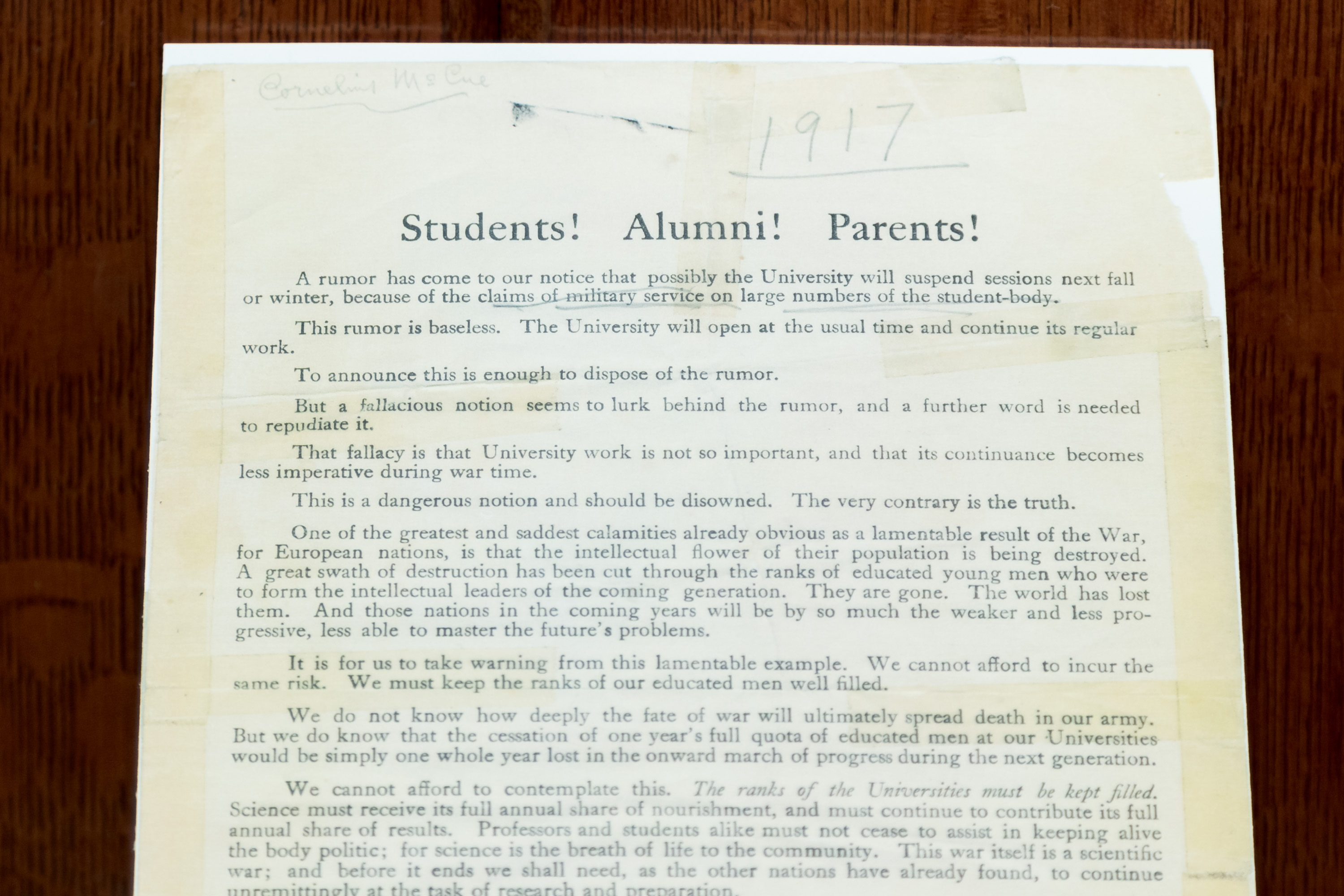 A 1917 letter from then-DePaul President Francis X. McCabe, C.M., to the faculty, staff and students telling them that the university would remain open during the Great War. (DePaul University/Jeff Carrion)CHICAGO — When U.S. President Woodrow Wilson declared war on the German
Empire April 6, 1917, one Lincoln Park neighborhood family with DePaul
University ties was changed forever. Now 100 years after the U.S. joined the
Great War, known more commonly as World War I, the story of the Ward family —
and their ties to the university, St. Vincent de Paul Parish and Chicago — is
the subject of a new exhibit titled “Glimpses of the Great War.” The display of
memorabilia will run through August at the John T. Richardson Library on
DePaul’s Lincoln Park Campus.
A 1917 letter from then-DePaul President Francis X. McCabe, C.M., to the faculty, staff and students telling them that the university would remain open during the Great War. (DePaul University/Jeff Carrion)CHICAGO — When U.S. President Woodrow Wilson declared war on the German
Empire April 6, 1917, one Lincoln Park neighborhood family with DePaul
University ties was changed forever. Now 100 years after the U.S. joined the
Great War, known more commonly as World War I, the story of the Ward family —
and their ties to the university, St. Vincent de Paul Parish and Chicago — is
the subject of a new exhibit titled “Glimpses of the Great War.” The display of
memorabilia will run through August at the John T. Richardson Library on
DePaul’s Lincoln Park Campus.
“’Glimpses of the Great War’ is sort of a commemorative exhibit in
honor of the centennial of World War I, but it really touches on a critical
time for the university with expansion, new programs and the addition of women
students,” said Andrea Bainbridge, university archivist. “The exhibit looks at
DePaul leading up to the war and in the decade following as it was growing.
DePaul really became a modern university during that time period, especially in
the 1920s.”
The exhibit centers on the Ward family and their nine children who grew
up on Fullerton Avenue, four blocks from St. Vincent de Paul Parish in Chicago,
according to Bainbridge. All eight male children attended DePaul Academy, a
high school run by the parish. Five served in the Great War and two died. Brothers
William and Joe were enrolled at the Vincentian Seminary in Perryville,
Missouri, preparing to be priests, during the war, added Lisa Geiger, special
collections’ archives processing assistant.
In the years following ordination, William returned to Chicago as principal
of DePaul Academy as part of eight decades of service to the order that took
him around the world. Joe, meanwhile, became a DePaul University English
professor and later served as the coordinator of college alumni before passing
away in 1978. At the time of Joe’s passing, DePaul’s enrollment had risen to
more than 12,000, a significant difference from the roughly 300 who attended
with the Wards in the early days of the university, according to Geiger.
“We talk all the time in special collections about whose history we are
trying to preserve; DePaul’s, the Vincentians’ and Lincoln Park’s. The story of
the Wards checks all three boxes,” said Bainbridge. “Their story goes a lot
deeper than we originally thought. This family is present across all these
different groups of records. The process of discovering just how deep the ties
are between this family, the parish and the neighborhood was amazing. To me,
that’s why it’s such a great story and one that’s perfect for the library’s
Special Collections and Archives department to tell.”
Bainbridge — with the help of Geiger — unearthed photos, memorabilia
and letters from the 1910s to the 1970s, which reveal the changes to DePaul’s
campus and the family. Items in the exhibit include:
- Memorial cards for both Ward brothers who died
in the war. William led the funeral service for his brother Albert in 1919,
before William and Joe led a funeral mass together for brother Oliver in 1921.
- A 1918 issue of The Minerval, DePaul’s
bi-monthly version of a student newspaper at the time, which featured updates
on soldiers with DePaul ties and letters from the front lines.
- A series of encouraging letters to the DePaul
community by then-President Francis X. McCabe, C.M., who also served as the
pastor of St. Vincent de Paul Parish. One of these letters was to confirm that
the university would remain open throughout the war.
- An original copy of the Field Service Pocket
Book, a U.S. military issued book small enough to fit in a pocket that covered
basic procedures for expected conditions in Europe.
- A Navy recruitment poster circa 1917.
All told, 584 people with DePaul ties including undergraduates, alumni
and faculty members served in the military during World War I, according to
Bainbridge.
The exhibit, which is open to the public through August, is on the
first floor of the John T. Richardson Library, 2350 N. Kenmore Ave. Students,
staff and community members are invited to an opening reception from 4-6 p.m.
April 12.
###
Sources:
Andrea Bainbridge
abainbri@depaul.edu
773-325-1746
Lisa Geiger
lgeiger3@depaul.edu
773-325-7864
Media Contact:
Russell Dorn
rdorn@depaul.edu
312-362-7128